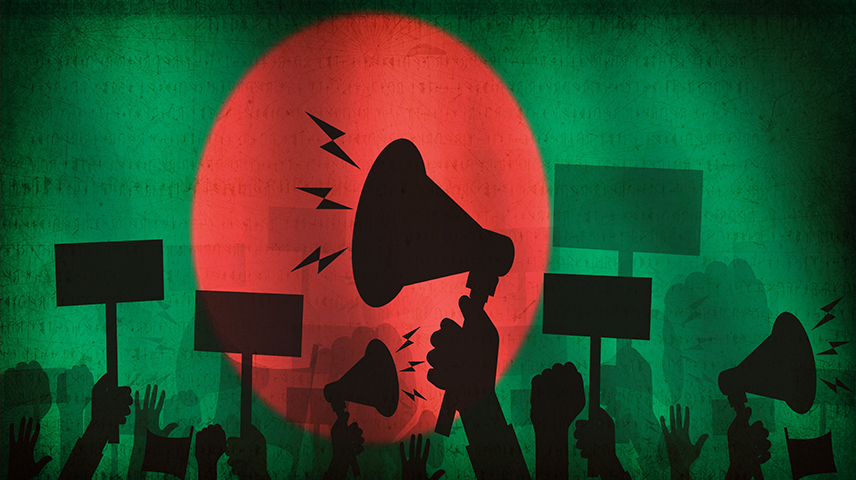In early July 2024, Bangladesh erupted in unprecedented, violent nationwide anti-government protests, sparked by outrage over the quota system in public sector jobs. The unrest has resulted in at least 190 fatalities, prompting authorities to impose curfews and deploy the army. Many observers view this crisis as the most significant challenge to Prime Minister Sheikh Hasina's leadership since her fourth consecutive election victory in January. This analysis delves into the underlying causes, recent developments, and potential ramifications of the ongoing protests in Bangladesh.
Reasons for the Protests
The angry protests were sparked by a Supreme Court order issued on June 5th to reinstate the quota system in government jobs. A large segment of the population opposes this new law, which they believe is discriminatory and unfair, especially given that public sector jobs are perceived as more stable and better paid than those in the private sector. More than 400,000 graduates compete for just 3,000 jobs annually. Consequently, the return to the quota system has triggered violent reactions and widespread protests.
The job quota system in Bangladesh was established in 1972 to support various groups and has since undergone several amendments. The latest version allocates approximately 56% of public sector jobs to specific groups: 30% to families of those who fought in Bangladesh's 1971 War of Independence from Pakistan, 10% to women, 10% to people from underdeveloped areas, 5% to indigenous populations, and 1% to people with disabilities. Protesters are calling for the abolition of these privileges, with the exception of quotas for indigenous populations and individuals with disabilities.
Escalation Trends
The nature of the protests and the government's response can be understood through three main patterns:
1. Widening protests:
The protests in Bangladesh have escalated into nationwide unrest. What began at the University of Dhaka, the country's oldest university, quickly spread to other institutions, evolving into an unprecedented wave of demonstrations. On July 18, protesters called for a nationwide shutdown, exempting only hospitals and emergency services. Students from private and public universities, as well as high schools, joined the movement, creating a unified front against the government.
2. Government downplay of crisis:
Initially, government representatives and the ruling Awami League party denied involvement in the crisis. They claimed no connection to the reinstated quota system, asserting that the verdict came from the Supreme Court. They suggested protesters await the court's appeal session, scheduled for August 7. However, Prime Minister Sheikh Hasina's statements on July 14th marked a turning point. Defending the law, she questioned whether the grandchildren of "Razakars" (collaborators with the Pakistani occupation army in 1971) should receive quota benefits if the grandchildren of freedom fighters did not. This inflammatory rhetoric further angered protesters and mobilized her opponents.
3. Deadly clashes replacing dialogue:
Instead of engaging in dialogue or offering flexible responses to protesters' demands, the Bangladeshi government has chosen confrontation. This approach has sparked widespread unrest, resulting in 151 deaths by July 21. The government imposed a nationwide curfew, deployed the army, banned public gatherings, and disrupted internet and mobile phone services. These measures aim to curb the use of social media for mobilization against the government. Officials justified slowing internet connectivity as a means to prevent the spread of misinformation about the protests.
Potential Impact
The ongoing protests in Bangladesh could have several potential impacts:
1. Government concessions:
Drawing parallels to the 2018 protests against the quota system, which led to its suspension and eventual abolition (later reinstated by the Supreme Court in June this year), the government might offer concessions to prevent the situation from escalating further.
In response to the recent unrest, the Supreme Court expedited its decision on the job quota system, originally scheduled for August. On July 21, the court ruled to significantly reduce the quota system without entirely abolishing it. The new ruling decreased the total percentage of jobs allocated to specific groups from 56% to a mere 7%. Notably, the reservation for children of "freedom fighters" from the 1971 War of Independence was reduced from 30% to 5% of public sector jobs. This particular quota has been a source of contention among university graduates, who perceive it as a means for the ruling party to reward its supporters. Additionally, 1% of public sector jobs will be allocated to indigenous groups, and another 1% to people with disabilities and members of the hijra community (recognized as a third gender under Bangladeshi law). Consequently, 93% of public sector jobs will now be awarded based on merit. However, student groups organizing the protests have rejected this decision, vowing to continue their demonstrations.
2. Increased political polarization:
The protests could exacerbate the already tense political climate in Bangladesh, a situation that has been deteriorating since the last elections in January 2024. These elections were marred by a boycott from major opposition parties, including the Bangladesh Nationalist Party (BNP). The opposition is likely to capitalize on the current protests to intensify pressure on the government, with BNP supporters already endorsing the protesters' demands.
While the reinstatement of the quota system in the public sector has certainly contributed to the polarization, it appears to be more of a catalyst than the root cause. The protests seem to be an expression of underlying tensions that have been simmering for years. Given these circumstances, political instability is likely to persist in the foreseeable future.
If the protests continue, they could further strain the economy by diverting the government's attention and resources away from much-needed economic improvement efforts.
In conclusion, Prime Minister Sheikh Hasina's government faces formidable challenges, compelling it to consider further concessions, economic adjustments, and political reforms to assuage public sentiment and address the mounting student and civilian discontent. The protests against the job quota system serve as a stark warning for the administration, urging a critical reassessment of its policies. The current climate of tension and polarization, if left unaddressed, risks further escalation.


